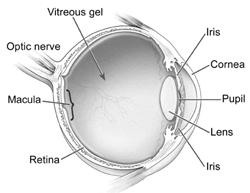 New Drug Delivery Mechanism For Retinopathy: A pin-sized device implanted behind the eye to treat diabetic retinopathy has been developed by a team of engineers and scientists from the University of British Columbia that could be told to release drugs to treat the damage.
New Drug Delivery Mechanism For Retinopathy: A pin-sized device implanted behind the eye to treat diabetic retinopathy has been developed by a team of engineers and scientists from the University of British Columbia that could be told to release drugs to treat the damage.
This is a new drug delivery mechanism, and the information about the mechanism was published in Lab on a Chip. Lab on a Chip is a multidisciplinary journal on innovative microfluidic and nanofluidic technologies.
The study was conducted by scientists and engineers at the University of British Columbia. The lead authors are Fatemeh Nazly Pirmoradi, a recent Ph.D. Mechanical Engineering Graduate, who completed the study for her doctoral thesis; and Mechanical Engineering Associate Professor Mu Chiao, who studies nanoscience and microelectromechanical systems for biological applications. The co-authors are Professor Helen Burt and research scientist John Jackson of the Faculty of Pharmaceutical Sciences.
Currently, diabetic retinopathy (the damage of blood vessels in the eye) is treated through laser treatment and anti-cancer drugs.
With laser treatment, some peripheral vision can be lost, as well as some loss of night vision, with each new laser procedure that is done on the afflicted eye.
With anti-cancer drugs, the problem that has been encountered is that the drugs quickly clear from the bloodstream so high doses are required, and these higher doses expose other tissues to toxicity.
One of the important things about this new research is that the delivery system would be through an external magnetic field. The research showed that by sealing the reservoir of the implanted device with an elastic magnetic polydimethylisiloxane (silicone) membrane, a specific amount of the drug could be discharged, just like squeezing a little pump.
In a series of lab tests, the University of British Columbia researchers and engineers inserted the pin-sized device with the drug docetaxel (trade name Taxotere, which is an anti-mitotic chemotherapy that is mainly used for the treatment of breast, ovarian and non-small cell lung cancer at this time). After 35 days, the device had kept its integrity with negligible leakage.
It will be several years before the University of British Columbia’s device is ready for use in patients.
Diabetic retinopathy is a leading cause of blindness in American adults. It causes changes in the blood vessels of the retina. These changes in the blood vessels cause them to swell and leak fluid. As well, there can be abnormal new blood vessels that grow on the surface of the retina. The retina of the eye is the light-sensitive tissue at the back of the eye. You have to have a healthy retina in order to have good vision. It is very important to have your eyes checked by a specialist on a regular basis so that any internal change in your retina can be detected by your doctor.
There are various stages of diabetic retinopathy:
- Mild nonproliferative, which is small areas of balloon-like swelling in the retina’s tiny blood vessels.
- As the retinopathy goes unchecked, some blood vessels that nourish the retina are blocked.
- A lot more blood vessels in the retina are blocked, stopping several areas of the retina from their blood supply. At this stage, the retina sends signals to the body to grow new blood vessels for nourishment.
- Advanced stage of retinopathy: Many more blood vessels are blocked, depriving several areas of the retina with their blood supply. These areas of the retina send signals to the body to grow new blood vessels for nourishment. This is called “proliferative retinopathy.” The new blood vessels that are grown are abnormal and fragile. They grow along the retina and along the surface of the clear, vitreous gel that fills the inside of the eye. These new blood vessels do not cause symptoms or vision loss. But, these new blood vessels are thin and have fragile walls. When leakage of blood occurs, severe vision loss and blindness can occur.
Any new treatment that is being worked on by researchers and engineers in the treatment of diabetic retinopathy is a step forward in preventing blindness in diabetic patients. In the meantime, have your eyes checked regularly.